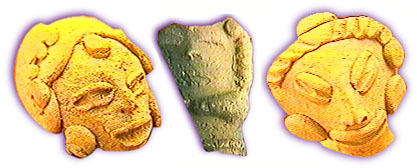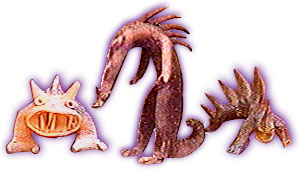
realtests -
http://www.realtests.com/admission/CDL.htm
test-inside -
http://www.test-inside.com/CCIP-certification.htm
examsheets -
http://www.examsheets.com/onlinetest/PMP.htm
braindumps -
http://www.braindumps.com/pass/ccna-syllabus.htm
selftestengine -
http://www.selftestengine.com/ccent-certification.html
Strange Clay Statues, 1500 Years Old, Puzzle Archaeologists
One of the best books I have ever read (although I didn't realize it at the time) was The Structure of Scientific Revolutions by Thomas Kuhn. The main revelation of this book was that science, rather than evolving from one discovery to the next with smooth, logical and empirical purity, is subject to an evil called a "paradigm." Kuhn's "paradigm" is the adherence of science to a particular idea, often even in the face of conflicting evidence, resulting from a grand discovery. As time progresses and additional knowledge is gathered, there occasionally appear to be facts that contradict the previaling belief and these unexplained facts are usually censored or suppressed. Eventually, however, a new theory will come along that allows for both the accepted findings and the previously "unexplained" and, when this happens, the new belief system is reluctantly accepted and becomes the next dogmatic paradigm.
Briefly, a paradigm is an idea, like, say, that the center of the Universe is planet Earth. This view, or paradigm, was held far beyond the discoveries of Copernicus because, simply speaking, it was convenient. The concept of God's creation, Earth, as being one of many planets rotating around a central sun seemed to contradict the fundamental views of the Bible and the early Christian church. It was this same church that imprisoned Copernicus as a heretic and sought to suppress this view for decades.
Back in this geocentric time, when the planets were viewed in the night sky, some odd movements were noted in the positions of Mars and Venus. These obvious planets seemed to move along the horizon, stop and then backtrack for a while, then resume their course. This minor glitch was ignored until it was proven by the deciples of Copernicus that these planetary movements were the result of expected and predicted observations being made of planets, from our own planet, all of which circle our Sun. Only then did the old paradigm die out.
The suppression of unusual ideas, or ideas that upset the current paradigm, are not just rare occurrances in science. These same prejudices exist today in a number of areas, not the least or which concerns the origins of humanity and the events of our Earth's past. Often, as we have seen with the Kennewick Man and the Piri Reis Map, there is the inclination to literally "cover up" certain archaeological findings that do not agree with the current dogmas. The Julesrod Collection, discussed here, and the Ica Stones (next issue) are two examples of this attempt to suppress valuable data.
The collection seems to have been the result of two distinct cultures. The oldest, stylized figures with large eyes and lips (above), were somewhat familiar to historians and resembled those of a culture that was known to exist in the area thousands of years before Columbus. Indeed, radiocarbon dating on these figures shows that they are 3500 years old. The other figures serve as the main controversy. They depict animals that strongly resemble camels, elephants, horses-- animals not indigenous to the area-- but also exact replications of certain dinosaur species thought to have been extinct for over 60 million years!
J U R A S S I C A R T

by Dan Eden
 About 50 years ago, an amateur archaeologist named Val Julesrod discovered some unearthed clay figurines along a trench at the base of Bull Mountain in Mexico. When speaking to local farmers, he learned that these were frequently encountered in shallow burials, in groups of from 20 to 40 pieces each, in a wide strip of land at the base of the mountain. He eventually began collecting and then excavating the area for more of these figurines and eventually had a collection of over thirty thousand!
About 50 years ago, an amateur archaeologist named Val Julesrod discovered some unearthed clay figurines along a trench at the base of Bull Mountain in Mexico. When speaking to local farmers, he learned that these were frequently encountered in shallow burials, in groups of from 20 to 40 pieces each, in a wide strip of land at the base of the mountain. He eventually began collecting and then excavating the area for more of these figurines and eventually had a collection of over thirty thousand!
The latter collection seems to be made from a singular clay source and has been dated to 1500 years old. This presents some problems to the current historical paradigm. Dinosaurs have been dug up and serious attempts to assemble their petrified remains only within the past 150 years. As early as two hundred years ago, the very existence of these gigantic creatures was largely unknown. In fact, new species are even now being discovered, buried deep in ancient Jurassic strata all over the world. Back 1500 years ago, the knowledge of dinosaurs was virtually unknown. Or was it?
If you have a suggestion or a photo to submit, send it to:
Editor/viewzone.com
myristicin@hotmail.com
